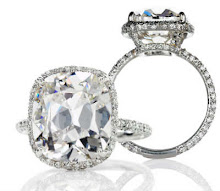Diamond Price Chart - Understand How Diamond Pricing Works
Those who are conscious of the changes in the diamond industry, and want the most up-to-date information available to consumers in order to find the diamond prices for the diamond of their dreams, should be encouraged to use the websites online which house information that is independent from specific diamond retailers or commercially involved sources. The first and probably most obvious factor in determining a diamond's price is its carat value. Naturally, people would immediately grasp the correlation between a diamond's size and its price, knowing that "the bigger - the better".
You may see two diamonds which look identical having the same clarity and color rating, yet the price is completely different. What it comes down to is that diamond prices are determined according to specific weight categories. The more the weight of the diamond, the higher is its price. The next contributing factor to determine diamond prices is the shape. Round brilliants are more expensive than fancy shapes and this is due to popular demand. Clarity is another factor that influences diamond prices.
Diamond price guides now exist for retailers and wholesalers who buy and sell diamonds to be able to evaluate the worth of one diamond against another in order for them to determine comparative retail pricing on diamonds of similar quality. The second factor that helps determine a diamond's price is its color. Putting aside fancy colored diamonds that are clearly much more expensive, white diamonds are graded according to their yellowish pigment display. There is a sharp variation of price between diamonds of different colors.
The third "C" that influences the way a diamond is priced is its clarity. The clarity scale measures the severity of the diamond's natural imperfections. The better the clarity grade of diamond is, the higher the price will get. Those who buy diamonds today are more cautious about the diamond price chart, and especially with the economic recession and tightening of purse strings, those who choose to acquire an expensive luxury commodity are more demanding about assurances given as to the quality and value of what they are buying.
The last factor that influences the value of a diamond is the cut. It is also the most deliberately neglected characteristic by a diamond salesperson when he or she attempts to make a sale. Generally, ideal cuts are considered much more expensive than their counterparts. Because there are now more ways of comparing the physical characteristics of diamonds to one another, some standardization of comparative diamond pricing has helped make the industry more stable, and make buying a diamond a more assured experience for the individual consumer.
Just as each diamond is unique on its own, so is the price of diamonds. Even diamonds that have the same exact carat size could be divided into a range of different prices, depending of course on the influence of their other qualities. In fact, the difference from one diamond ring to the next can easily be several thousand dollars. For most consumers, price is an important factor in a buying decision, so it is important to understand what you are paying for when you purchase a brilliant piece of diamond.








